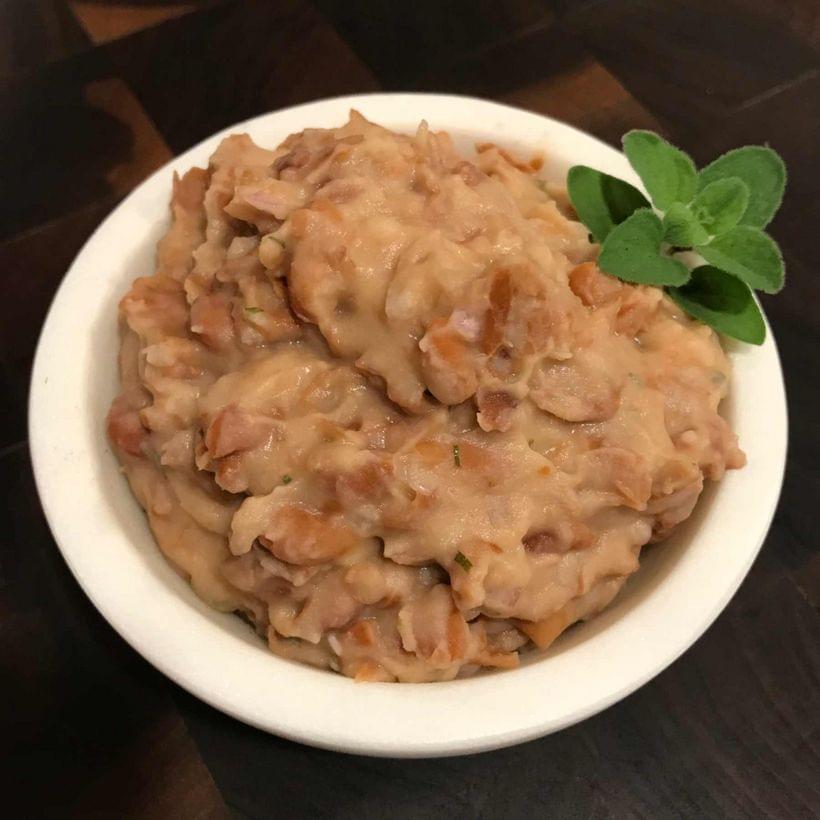Refried Beans
Skip to the recipe
A lot of people will tell you that really good refried beans can’t be made from canned beans. Well, I am here to tell you: okay, yeah, they’re probably right.
I’m not gonna tell you not to use dried beans, if you want to make a whole day of your refried bean adventure. Simmer ’em in a nice rich stock with a couple onion halves, a few smashed-up cloves of garlic, a bay leaf, and a handful of peppercorns for two or three hours. Throw it all in a pressure cooker (read: “Instant Pot, probably”) and you’re looking at something closer to half an hour before you get to the refried-ifying step—at which point, everything you’re about to read will apply.
I also keep a can of Goya pinto beans in the cabinet, because nachos are good as hell. If I were signing myself up for a refried bean contest, I’d do the soak-and-simmer routine for sure. For situations where the primary application can be best described as “glopped,” canned pintos are gonna do you just fine. Even on the side, I’m rarely mad about ’em.
The Herbs
Some people might tell you that oregano—warm, earthy oregano—has no place in refried beans. I am here to tell you that: again, yeah, maybe. I don’t know from “authenticity,” but I think plain ol’ Mediterranian oregano works okay. I’ve got some”hot and spicy” oregano growing out on the porch; it works well, for obvious reasons. Despite being a completely different plant, Mexican oregano doesn’t have an entirely different flavor—I think it has more of a menthol-y, bay-leaf-y taste to it. I like to infuse the fat with dried Mexican oregano at the beginning, and add a little fresh-from-the-porch oregano at the very end.
The Fats
Listen. I don’t know if you’ve picked up on the vibe here, but I’m not drawing a lot of hard-and-fast rules on this one. Traditionally, you’d use lard—which, again, if I were on Iron Chef: Battle Pinto Beans, absolutely. I don’t keep a squeeze bottle of lard next to my stove, though—vegetable oil does the job, even if it is a missed opportunity for adding flavor. I also have a 50/50 mix of oil and butter squeeze-bottle’d—which has nothing to do with smoke points and everything to do with flavors—but a little butter doesn’t seem to add much of anything in the way of flavor. Olive oil is wasted; any flavor it would impart is obliterated by all the other strong, earthy flavors in play. Bacon drippings work great if you want your refried beans to taste like bacon drippings—and no judgement if you do.
Lard imparts richness in a balanced way; if you’ve got it handy, use it. If not, vegetable oil works just fine. I’ve also used the Marmite trick in these; it works.
The Aromatics
The finely minced shallot at the end brightens up what would otherwise be a pretty heavy dish. Since this only uses half an onion at the outset, which is a little impractical, I’ll sometimes add another teaspoon or so of onion—minced a little finer—at the end instead.
The Beans
Pinto. Black beans are for soup.
Yeah, I said it.
Fight me.
Recipe: Refried Beans
Ingredients
-
1 Tbsp. Lard, or a neutral oil
-
3 Cloves Garlic, minced
-
1/2 Yellow Onion, minced
-
1/2 tsp. Mexican Oregano, dried
-
A pinch Chili Powder, or a dash of your favorite hot sauce
-
A pinch Ground Cumin
-
1 Shallot, finely minced
-
11/2 C. Pinto Beans, or one can
-
A splash Stock, or reserved liquid from reconstituting dried beans
-
Salt and black pepper, to taste
Instructions
in a 3qt. saucepan, heat lard/oil until shimmering, over medium heat. Add minced onion and garlic and cook, stirring occasionally, until onion is translucent.
Add herbs and cumin and cook until fragrant—only a minute or two. Stir in beans—drained, if from a can. Cook for a few minutes, stirring occasionally.
Add stock (ideally the stock you simmered them in, if you’re using previously-dried beans) to cover, and simmer—uncovered—until the beans start to separate from their skins.
Mash with the back of a spoon for a texture like the one pictured, or use an immersion blender to make a smoother purée. It’ll thicken more than you might expect; add stock in small amounts until you’ve reached your desired consistency.
Stir in chili powder or hot sauce, salt and pepper to taste, and finely minced shallots, and serve.